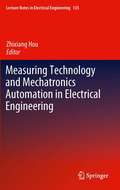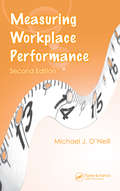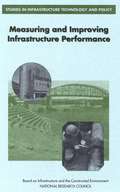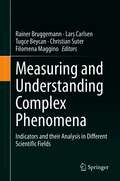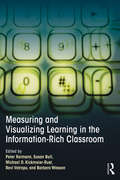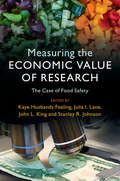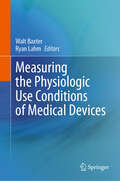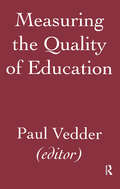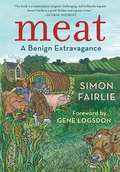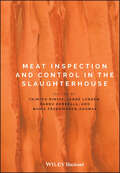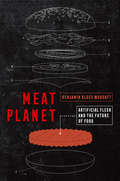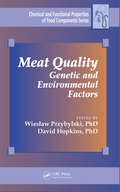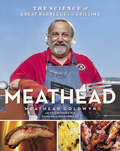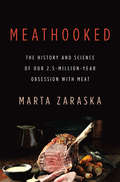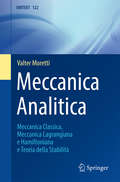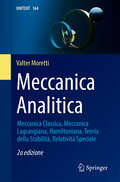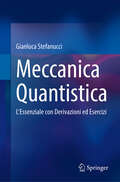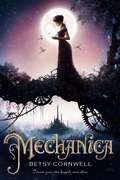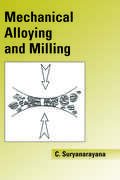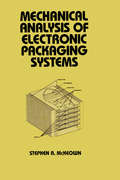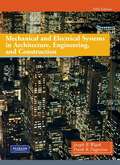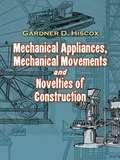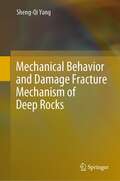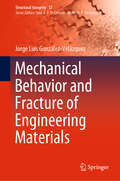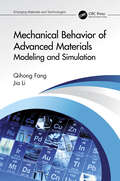- Table View
- List View
Measuring Technology and Mechatronics Automation in Electrical Engineering
by Zhixiang HouMeasuring Technology and Mechatronics Automation in Electrical Engineering includes select presentations on measuring technology and mechatronics automation related to electrical engineering, originally presented during the International Conference on Measuring Technology and Mechanatronics Automation (ICMTMA2012). This Fourth ICMTMA, held at Sanya, China, offered a prestigious, international forum for scientists, engineers, and educators to present the state of the art of measuring technology and mechatronics automation research.
Measuring Workplace Performance
by Michael J. O'NeillMost Fortune 1000 companies still struggle with workspace planning and design issues. They invest millions of dollars each year with the expectation that new buildings and major renovations will help transform their culture, support innovation, strengthen desired behaviors and increase organizational effectiveness. Providing a biological framework, this book explores how the design of the work environment can be used as a tool to further business goals as well as improve individual and group performance. The second edition of a bestseller, the book includes many new case studies with Fortune 1000 companies. It features a new section on Six Sigma measurement methods for assessing office workspace effectiveness. The Case Studies demonstrate how office workspace design affects employee performance, and how to use this information to optimize workplace design for individuals and groups. It focuses on the emergence and application of Six-Sigma quality principles and methods in the evaluation and improvement of workspaces.
Measuring and Improving Infrastructure Performance
by National Research CouncilThe nation's physical infrastructure facilitates movement of people and goods; provides safe water; provides energy when and where needed; removes wastes; enables rapid communications; and generally supports our economy and quality of life. Developing a framework for guiding attempts at measuring the performance of infrastructure systems and grappling with the concept of defining good performance are the major themes of this book. Focusing on urban regions, within a context of national policy, the volume provides the basis for further in-depth analysis and application at the local, regional, state, and national levels.
Measuring and Understanding Complex Phenomena: Indicators and their Analysis in Different Scientific Fields
by Christian Suter Filomena Maggino Lars Carlsen Rainer Bruggemann Tugce BeycanIndicators are more and more applied to describe and analyze complex systems. Typical examples: Innovation potential of nations, child-well being, Environmental health, poverty, chemical pollution, corruption of nations. The task is: How can a system of indicators be defined in order to fulfill the above expectations. One possibility is the application of the mathematical theory of partial order, especially when the indicator system shall be used for ranking purposes.
Measuring and Visualizing Learning in the Information-Rich Classroom
by Peter Reimann Barbara Wasson Michael Kickmeier-Rust Ravi Vatrapu Susan BullIntegrated information systems are increasingly used in schools, and the advent of the technology-rich classroom requires a new degree of ongoing classroom assessment. Able to track web searches, resources used, task completion time, and a variety of other classroom behaviors, technology-rich classrooms offer a wealth of potential information about teaching and learning. This information can be used to track student progress in languages, STEM, and in 21st Century skills, for instance. However, despite these changes, there has been little change in the kind of data made available to teachers, administrators, students, and parents. Measuring and Visualizing Learning in the Information-Rich Classroom collects research on the implementation of classroom assessment techniques in technology-enhanced learning environments. Building on research conducted by a multinational and multidisciplinary team of learning technology experts, and specialists from around the globe, this book addresses these discrepancies. With contributions from major researchers in education technology, testing and assessment, and education psychology, this book contributes to a holistic approach for building the information infrastructure of the 21st Century school.
Measuring the Economic Value of Research: The Case Of Food Safety
by Kaye Husbands Fealing Julia I. Lane John L. King Stanley R. JohnsonThe scientific advances that underpin economic growth and human health would not be possible without research investments. Yet demonstrating the impact of research programs is a challenge, especially in areas that span disciplines, industrial sectors, and encompass both public and private sector activity. All areas of research are under pressure to demonstrate benefits from federal funding of research. This exciting and innovative study demonstrates new methods and tools to trace the impact of federal research funding on the structure of research, and the subsequent economic activities of funded researchers. The case study is food safety research, which is critical to avoiding outbreaks of disease. The authors make use of an extraordinary new data infrastructure and apply new techniques in text analysis. Focusing on the impact of US federal food safety research, this book develops vital data-intensive methodologies that have a real world application to many other scientific fields.
Measuring the Physiologic Use Conditions of Medical Devices
by Walt Baxter Ryan LahmThe physiologic use conditions medical devices are subjected to during implant and long-term in vivo use are critical to ensuring device reliability, efficacy, and safety. This book highlights advanced analyses for measuring the physiologic use conditions of medical devices, introducing important challenges facing engineers. The chapters include: A working definition for the physiologic in vivo use conditions used to further improve medical device performance in patients. Introductions to common approaches used to measure medical device use conditions so that engineers can use similar techniques where useful. Detailed case studies that highlight problem statements, approaches for measuring physiologic use conditions, and example outputs from such analyses. This book provides an up-to-date resource for device engineers so that they can accurately measure conditions that devices experience during and after implantation—key to reliability testing, computational modeling, and choosing optimum designs. This is an ideal book for medical device engineers and scientists designing and manufacturing devices for human use, students interested in understanding how devices interact with anatomy, and academic researchers seeking to apply advanced analyses to unmet use condition needs in the medical device field.
Measuring the Quality of Education
by Paul VedderThis book contains a selection of articles on measuring the quality of education from the perspective of the importance of theories on education, changing effects of education, curriculum dependent or curriculum independent measurement, product and process evaluation, and global curricula.
Meat
by Simon FairlieFairlie, editor of Land Magazine and former livestock manager of a community farm in the UK offers a collection of essays on the environmental ethics of eating meat. He considers whether raising animals for meat is sustainable and along the way debunks many of the environmental arguments and statistics used to promote veganism and vegetarianism. Essays are grouped into the categories of land requirements for livestock, food security, energy and carbon, and land use change, and while UK centric, will be of interest to anyone concerned with making sustainable food choices. Fairlie does not address the morality of eating meat, nor does he discuss nutrition, but nevertheless provides a compelling argument for small-scale livestock farming as an environmentally sound practice. Several of the essays were published previously in Land Magazine and have been revised for this collection. Annotation ©2011 Book News, Inc. , Portland, OR (booknews. com)
Meat Inspection and Control in the Slaughterhouse
by Janne Lunden Thimjos Ninios Maria Fredriksson-Ahomaa Hannu KorkealaMeat inspection, meat hygiene and official control tasks in the slaughterhouse have always been of major importance in the meat industry, and are intimately related with animal diseases and animal welfare. The history of meat inspection has largely been a success story. Huge steps have been taken over more than a century to prevent the transmission of pathogenic organisms and contagious diseases from animals to humans. Various factors influence the quality and safety of meat including public health hazards (zoonotic pathogens, chemical substances and veterinary drugs), animal health and welfare issues during transport and slaughter.Meat inspection is one of the most important programs in improving food safety, and its scope has enlarged considerably over the last decades. Globalization has affected the complexity of the modern meat chain and has provided possibilities for food frauds and unfair competition. During the last two decades many food fraud cases have been reported, which have caused concern among consumers and the industry. Subsequently meat inspection is faced with new challenges.Meat Inspection and Control in the Slaughterhouse is an up-to-date reference book that responds to these changes and reflects the continued importance of meat inspection for the food industry. The contributors to this book are all international experts in the areas of meat inspection and the official controls limited to slaughterhouses, providing a rare insight into the international meat trade. This book will be of importance to students, professionals and members of the research community worldwide who aim to improve standards of meat inspection procedures and food safety.
Meat Planet: Artificial Flesh and the Future of Food (California Studies in Food and Culture #69)
by Benjamin Aldes WurgaftIn 2013, a Dutch scientist unveiled the world’s first laboratory-created hamburger. Since then, the idea of producing meat, not from live animals but from carefully cultured tissues, has spread like wildfire through the media. Meanwhile, cultured meat researchers race against population growth and climate change in an effort to make sustainable protein. Meat Planet explores the quest to generate meat in the lab—a substance sometimes called “cultured meat”—and asks what it means to imagine that this is the future of food.Neither an advocate nor a critic of cultured meat, Benjamin Aldes Wurgaft spent five years researching the phenomenon. In Meat Planet, he reveals how debates about lab-grown meat reach beyond debates about food, examining the links between appetite, growth, and capitalism. Could satiating the growing appetite for meat actually lead to our undoing? Are we simply using one technology to undo the damage caused by another? Like all problems in our food system, the meat problem is not merely a problem of production. It is intrinsically social and political, and it demands that we examine questions of justice and desirable modes of living in a shared and finite world. Benjamin Wurgaft tells a story that could utterly transform the way we think of animals, the way we relate to farmland, the way we use water, and the way we think about population and our fragile ecosystem’s capacity to sustain life. He argues that even if cultured meat does not “succeed,” it functions—much like science fiction—as a crucial mirror that we can hold up to our contemporary fleshy dysfunctions.
Meat Quality: Genetic and Environmental Factors (Chemical And Functional Properties Of Food Components Ser.)
by David Hopkins Wieslaw PrzybylskiOne of the biggest challenges faced by meat producers today is the requirement to improve the quality of meat while maintaining focus on efficiency and higher yields. Numerous studies have shown that consumers are willing to pay premiums for meat products with guaranteed eating quality. This book examines the complicated multistep process of produc
Meathead: The Science of Great Barbecue and Grilling
by Rux Martin Meathead GoldwynThe first book to apply the latest scientific research to America's favorite form of cooking, by the curator of the highly successful website Amazingribs.com, with 175 sure-fire recipes
Meathooked: The History and Science of Our 2.5-Million-Year Obsession with Meat
by Marta ZaraskaA few years ago, Marta Zaraska’s mother decided to go vegetarian after stumbling upon an article on the health risks of eating meat. Her resolve lasted about a fortnight before the juicy hams and the creamy pâtés began creeping back into her refrigerator. Prodded to explain her lapse, she replied, "I like meat, I eat it, end of story. ” Many of us have had a similar experience. What makes us crave animal protein, and what makes it so hard to give up? And if all the studies are correct, and consuming meat is truly unhealthy for us, why didn’t evolution turn us all into vegetarians in the first place? In Meathooked, Zaraska explores what she calls the "meat puzzle”: our love of meat, despite its harmful effects. Scientific journals overflow with reports of red meat raising the risk of certain cancers; each hamburger contributes as much to global warming as does driving a car 320 miles; and the horrors of industrial meat production are now well-known. None of these facts have prompted us to give up our hamburgers and steaks. On the contrary, meat consumption has only increased over the past decades. Taking the reader to India’s unusual steakhouses, animal sacrifices at temples in Benin, and labs in Pennsylvania where meat is being grown in petri dishes, Zaraska examines the history and future of meat and meat-eating, showing that while our increasing consumption of meat can be attributed in part to the power of the meat industry and the policies of our governments, the main "hooks” that keep us addicted to meat are much older: genes and culture. An original and thought-provoking exploration of carnivorousness, Meathooked explains one of the most enduring features of human civilization--and why meat-eating will continue to shape our bodies and our world into the foreseeable future.
Meccanica Analitica: Meccanica Classica, Meccanica Lagrangiana e Hamiltoniana e Teoria della Stabilità (UNITEXT #122)
by Valter MorettiIl testo parte da una rivisitazione teorica della meccanica classica newtoniana e del suo linguaggio matematico che si conclude con un'analisi critica della meccanica classica newtoniana. Si passa quindi alle formulazioni lagrangiane e hamiltoniane della meccanica classica, discutendo in particolare il rapporto tra simmetrie e costanti del moto all'interno di varie versioni del teorema di Noether e analoghi risultati. I capitoli sulla meccanica hamiltoniana, oltre al materiale standard come le parentesi di Poisson, la geometria simplettica, la formulazione di Hamilton-Jacobi e principi variazionali, includono alcuni risultati teorici importanti come il teorema di Liouville e il teorema di ricorrenza di Poincaré. La teoria della stabilità è introdotta e discussa nell'approccio di Liapunov. Il linguaggio adottato in tutto il testo è quello della geometria differenziale, che in ogni caso viene introdotta gradualmente. Un complemento finale include la teoria di base dei sistemi di equazioni differenziali ordinarie e dei sistemi con alcune generalizzazioni alla teoria sulle varietà. Diverse appendici introducono alcuni strumenti matematici come la teoria delle forme differenziali, la derivata di Lie e la teoria dell'integrazione su varietà. Il libro include diversi esercizi risolti.Il libro si rivolge agli studenti di Matematica e Fisica per i corsi di Meccanica Razionale e Meccanica Analitica.
Meccanica Analitica: Meccanica Classica, Meccanica Lagrangiana, Hamiltoniana, Teoria della Stabilità, Relatività Speciale (UNITEXT #164)
by Valter MorettiIl testo parte da una rivisitazione teorica della meccanica classica newtoniana e del suo linguaggio matematico che si conclude con un'analisi critica della meccanica classica newtoniana. Si passa quindi alle formulazioni lagrangiane e hamiltoniane della meccanica classica, discutendo in particolare il rapporto tra simmetrie e costanti del moto all'interno di varie versioni del teorema di Noether e analoghi risultati. I capitoli sulla meccanica hamiltoniana, oltre al materiale standard come le parentesi di Poisson, la geometria simplettica, la formulazione di Hamilton-Jacobi e principi variazionali, includono alcuni risultati teorici importanti come il teorema di Liouville e il teorema di ricorrenza di Poincaré. La teoria della stabilità è introdotta e discussa nell'approccio di Lyapunov. Nella seconda edizione è stata aggiunta una descrizione matematica della teoria della relatività speciale e di alcuni suoi sviluppi nell'ambito della formulazione lagrangiana ed hamiltoniana. Il linguaggio adottato in tutto il testo è quello della geometria differenziale, che in ogni caso viene introdotta gradualmente. Un primo complemento finale discute gli assiomi fisici su cui si basa la teoria della relatività speciale e come si passa da tali assiomi alla formulazione matematica. Un secondo complemento include la teoria di base dei sistemi di equazioni differenziali ordinarie e dei sistemi con alcune generalizzazioni alla teoria sulle varietà. Diverse appendici introducono alcuni strumenti matematici come la teoria delle forme differenziali, la derivata di Lie e la teoria dell'integrazione su varietà. Il libro include diversi esercizi risolti. Il libro si rivolge agli studenti di Matematica e Fisica per i corsi di Meccanica Razionale e Meccanica Analitica.
Meccanica Quantistica: L'Essenziale con Derivazioni ed Esercizi
by Gianluca StefanucciQuesto libro si basa sul corso "Elementi di Fisica Teorica" che l'autore insegna presso l'Università di Roma Tor Vergata dal 2017. Il volume serve come introduzione alla meccanica quantistica, fornendo agli studenti concetti e strumenti necessari per i corsi successivi senza fare eccessivo affidamento al livello di astrazione e rigore matematico tipicamente presenti nei programmi di fisica. La comprensione di questo libro richiede soltanto la conoscenza dei concetti matematici insegnati nei primi due anni dei corsi base. Il corso di laurea in Scienza dei Materiali mira a formare studenti con un background interdisciplinare in fisica, chimica e ingegneria. Sebbene lo studio della meccanica quantistica sia essenziale, non è necessario raggiungere lo stesso livello di profondità, astrazione e rigore matematico di un corso di laurea in Fisica. La maggior parte dei libri di testo sulla Meccanica Quantistica sono indirizzati agli studenti di Fisica, rendendo difficile trovare risorse adatte per gli studenti di Scienza dei Materiali. Per facilitare l'apprendimento, l'autore ha scelto di non rimandare gli studenti a diversi libri di testo per argomenti diversi. Ha creato invece delle dispense che si sono evolute in un libro di testo condensato sulla meccanica quantistica specificamente adattato alle esigenze del programma di Scienza dei Materiali.
Mechanica
by Betsy CornwellNicolette's awful stepsisters call her "Mechanica" to demean her, but the nickname fits: she learned to be an inventor at her mother's knee. Her mom is gone now, though, and the Steps have pushed her into a life of dreary servitude. When she discovers a secret workshop in the cellar on her sixteenth birthday--and befriends Jules, a tiny magical metal horse--Nicolette starts to imagine a new life for herself. And the timing may be perfect: There's a technological exposition and a royal ball on the horizon. Determined to invent her own happily-ever-after, Mechanica seeks to wow the prince and eager entrepreneurs alike.
Mechanical Alloying And Milling
by Cury SuryanarayanaThis book surveys the broad field of mechanical alloying from a scientific and technological perspective to form a timely and comprehensive resource valuable to both students and researchers. The treatment progresses from the historical background through a description of the process, the different metastable effects produced, and the mechanisms of
Mechanical Analysis of Electronic Packaging Systems
by Stephen A. McKeown"Fills the niche between purely technical engineering texts and sophisticated engineering software guides-providing a pragmatic, common sense approach to analyzing and remedying electronic packaging configuration problems. Combines classical engineering techniques with modern computing to achieve optimum results in assessment cost and accuracy."
Mechanical And Electrical Systems In Architecture, Engineering And Construction
by Frank Dagostino Joseph WujekThe book provides comprehensive, easy-to-understand introductory coverage of mechanical and electrical systems in buildings. Elementary engineering concepts and step-by-step design principles are introduced in a straightforward manner and supported by over 320 illustrations and 500 photographs. It includes new chapters on emerging sustainability (green) technologies and building science. It presents material that can provide the future architect, architectural engineer, and architectural engineering technician with a basic working-level knowledge of principles and practices. This book is written specifically for those interested in building heating, ventilating and air conditioning (HVAC), plumbing and piping (water supply and sanitary drainage), storm drainage, illumination, electrical power distribution, building telecommunications, acoustics and acoustical control, vertical/horizontal transportation and conveying, fire protection and suppression, and building renewable energy and energy conservation systems.
Mechanical Appliances, Mechanical Movements and Novelties of Construction
by Gardner D. HiscoxFrom the devices that power ships and trains to the workings of clocks, typewriters, and guns, this engrossing visual narrative profiles the specific and unique properties of hundreds of mechanical devices. Nearly 1,000 detailed illustrations depict steam-powered appliances, spring-powered devices, hydraulic equipment, and other machines, many of which remain in common use today. Each apparatus features a detailed line drawing and an informative explanation of its workings and uses. A final chapter chronicles 400 years of impassioned but futile searching for a perpetual motion machine.The companion to Dover's 1800 Mechanical Movements, Devices and Appliances, this volume features fewer but more complex machines than its predecessor. Today's readers--especially engineers, inventors, and other mechanically inclined individuals--will find endless fascination and inspiration among the novelty and variety of these ingenious mechanical designs.
Mechanical Behavior and Damage Fracture Mechanism of Deep Rocks
by Sheng-Qi YangThis book presents mainly experimental studies on the mechanical behavior and damage fracture mechanism of deep rocks including sandstone, marble, mudstone and granite, combining with several advanced technologies of X-ray micro-CT and AE monitoring.It has several unique features: 1) Investigates the influence of loading path on triaxial strength and deformation behavior of sandstone and marble; 2) Analyzes the effect of borehole size on triaxial strength and deformation behavior of hollow sandstone; 3) Explores the influence of high temperature on triaxial deformation and permeability behavior of sandstone and granite; 4) to reveal the damage fracture mechanism of deep rocks using spatial AE techniques and X-ray micro CT observations. This work will appeal to a wide readership from technicians in the field of geotechnical engineering and engineering geology to scholars carrying out research in the rock mechanics.
Mechanical Behavior and Fracture of Engineering Materials (Structural Integrity #12)
by Jorge Luis González-VelázquezThis book presents the theoretical concepts of stress and strain, as well as the strengthening and fracture mechanisms of engineering materials in an accessible level for non-expert readers, but without losing scientific rigor. This volume fills the gap between the specialized books on mechanical behavior, physical metallurgy and material science and engineering books on strength of materials, structural design and materials failure. Therefore it is intended for college students and practicing engineers that are learning for the first time the mechanical behavior and failure of engineering materials or wish to deepen their understanding on these topics.The book includes specific topics seldom covered in other books, such as: how to determine a state of stress, the relation between stress definition and mechanical design, or the theory behind the methods included in industrial standards to assess defects or to determine fatigue life. The emphasis is put into the link between scientific knowledge and practical applications, including solved problems of the main topics, such as stress and strain calculation. Mohr's Circle, yield criteria, fracture mechanics, fatigue and creep life prediction. The volume covers both the original findings in the field of mechanical behavior of engineering materials, and the most recent and widely accepted theories and techniques applied to this topic. At the beginning of some selected topics that by the author's judgement are transcendental for this field of study, the prime references are given, as well as a brief biographical semblance of those who were the pioneers or original contributors. Finally, the intention of this book is to be a textbook for undergraduate and graduate courses on Mechanical Behavior, Mechanical Metallurgy and Materials Science, as well as a consulting and/or training material for practicing engineers in industry that deal with mechanical design, materials selection, material processing, structural integrity assessment, and for researchers that incursion for the first time in the topics covered in this book.
Mechanical Behavior of Advanced Materials: Modeling and Simulation (Emerging Materials and Technologies)
by Jia Li Qihong FangWith the recent developments in the field of advanced materials, there exists a need for a systematic summary and detailed introduction of the modeling and simulation methods for these materials. This book provides a comprehensive description of the mechanical behavior of advanced materials using modeling and simulation. It includes materials such as high-entropy alloys, high-entropy amorphous alloys, nickel-based superalloys, light alloys, electrode materials, and nanostructured reinforced composites. Reviews the performance and application of a variety of advanced materials and provides the detailed theoretical modeling and simulation of mechanical properties Covers the topics of deformation, fracture, diffusion, and fatigue Features worked examples and exercises that help readers test their understanding This book is aimed at researchers and advanced students in solid mechanics, material science, engineering, material chemistry, and those studying the mechanics of materials.
